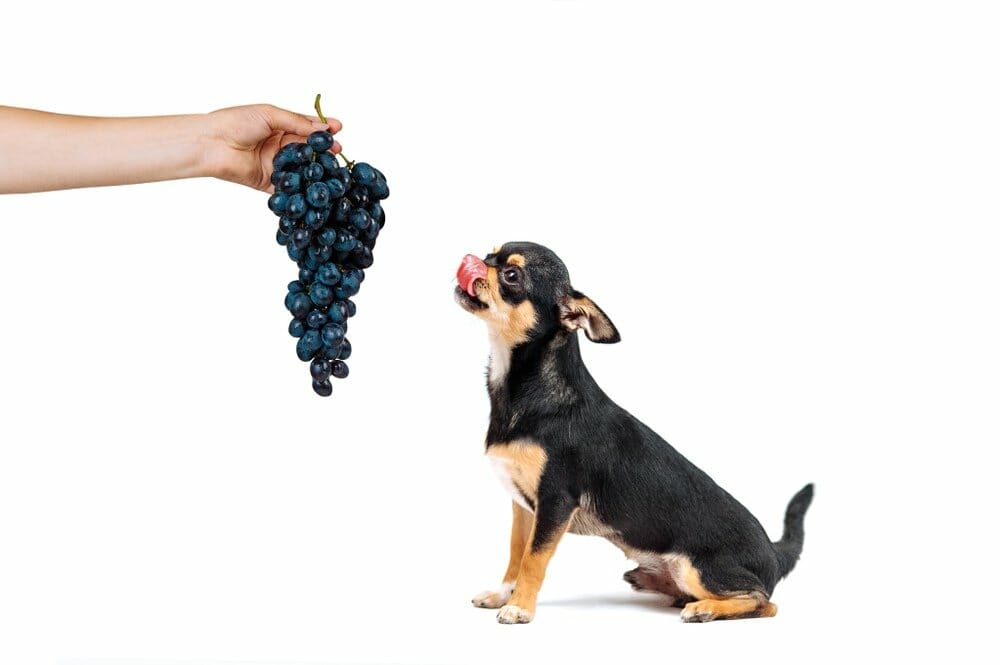Last updated: July 18, 2022
Your dog will eat just about anything you give them, especially if you’re eating it, too. While it’s always tempting to give your dog tidbits, it’s not always a good idea, especially when it comes to grapes. Humans can eat grapes, but can dogs eat grapes?
Two questions that grape-loving pet parents may want to research include:
- Are grapes good for dogs?
- Are grapes poisonous for dogs?
We know that some of the table scraps and human food we spoil our pets with might not be the healthiest for them, but the last thing you want to do is share something with your pet that may end up being toxic.
Let’s delve into whether grapes are toxic for dogs.
Can Dogs Eat Grapes or Raisins?
The answer is no. Grapes, and all grape products are toxic to dogs. Raisins, sultanas, and currants are all dried grapes, and the toxicity concern remains the same.
Grapes come in different colors and varieties, so it’s normal to wonder if dogs can eat at least one type – perhaps green grapes or red ones. You should note that there are no safe grapes for dogs. Grapes of all colors and varieties should be avoided. These include the red, green, or purple ones and those with and without seeds.
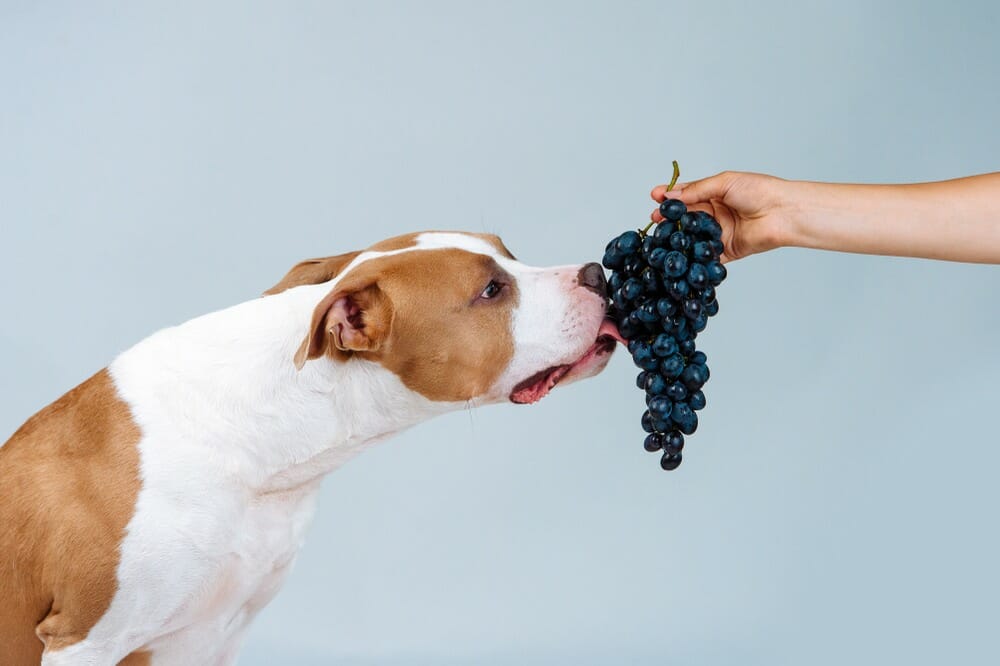
Both seeded and seedless grape varieties are poisonous to dogs; this includes homegrown or commercial grapes, organic or non-organic varieties, and even grape pressings from wineries. Foods like raisin bran cereal, granola mix, trail mix, or baked goods containing grapes, raisins, or currants are all potential sources of poison for your pet.
You should ensure your dog has no access to grapes or grape products at all times.
Your dog’s age, gender, or breed does not change the risk of being affected. All visitors and family members must be aware that grapes are toxic to dogs, and they should never give them to your dog.
Why are Grapes Bad for Dogs?
Grape toxicity in dogs can result in severe kidney damage, causing sudden or acute kidney failure that can be fatal. The exact toxic substance in grapes has remained a mystery for a long time.
Many theories exist about the poisonous component of grapes and raisins, but research and findings have been limited until recently.
However, not long ago, a group of veterinarians from the American Society for the Prevention of Cruelty to Animals (ASPCA) and the Animal Poison Control Center (APCC) recently made a breakthrough – all thanks to playdough.
In a letter published in the most recent American Veterinary Medical Association Journal, the vets note that tartaric acid may explain why grapes are toxic to pets. Tartaric acid entered the spotlight when the APCC consulted on a case involving homemade playdough made with cream of tartar, which contains the potassium salt of tartaric acid, potassium bitartrate.
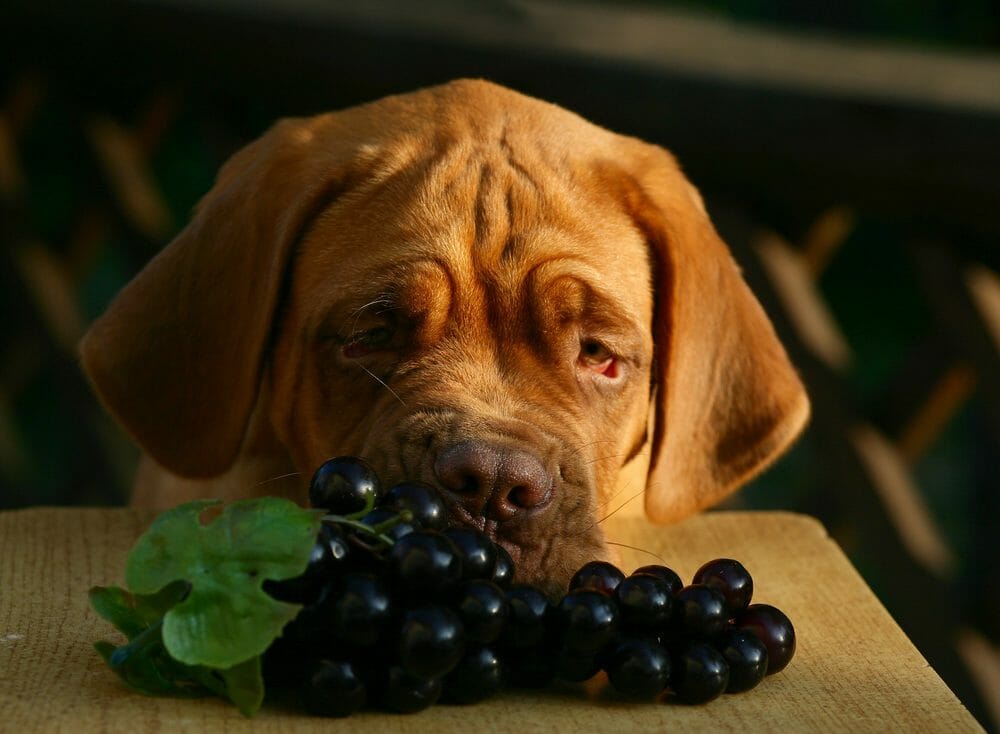
Potassium bitartrate and tartaric acid are uniquely present in high concentrations in grapes, and dogs are sensitive to tartaric acid, with reports of acute renal failure in older studies. Grapes contain varying amounts of tartaric acid depending on their type, ripeness, and how they’re grown. This can explain why some pets get very sick while others seem unaffected after eating a similar number of raisins or grapes.
Similarly, different dogs can respond differently to ingesting grapes. Some can eat a handful or bag of raisins before they are affected, while others can get sick after eating only one grape.
More research is required to know how best to treat dogs that have ingested raisins or grapes. The problem is that it’s unlikely to know which dog will develop kidney failure and which one won’t, and waiting to find out can be fatal.
Tartaric acid was not previously suspected as a possible toxic component because it has a wide range of (safe) uses for humans and is commonly used on lab animals like mice, while studies on dogs remain outdated.
Symptoms of Grape Poisoning in a Dog
Symptoms of poisoning usually occur from 12 to 24 hours after a dog eats grapes or raisins.
Symptoms include:
- Vomiting and diarrhea within a few hours of ingestion, and you may even observe pieces of raisins or grapes in your dog’s vomit or stool
- Excessive thirst (polydipsia) and increased urination in the initial stages
- Absent or decreased urination if your dog’s kidney starts shutting down
- Unusual quietness, lethargy, or weakness
- Loss of appetite
- Bad breath
- Dehydration
Vomiting is the most common early symptom, while lethargy, possible diarrhea, and lack of appetite often occur within the next 12 to 24 hours. Severe signs are often not seen until 24 to 48 hours after ingestion, and they only emerge after the start of acute kidney damage.
Symptoms of acute kidney failure include appetite loss, nausea, vomiting, bad breath with an ammonia or uremic odor, abdominal pain, excessive thirst, diarrhea, and excessive urination. The kidney will stop functioning as the poisoning progresses, and your dog may be unable to produce urine.
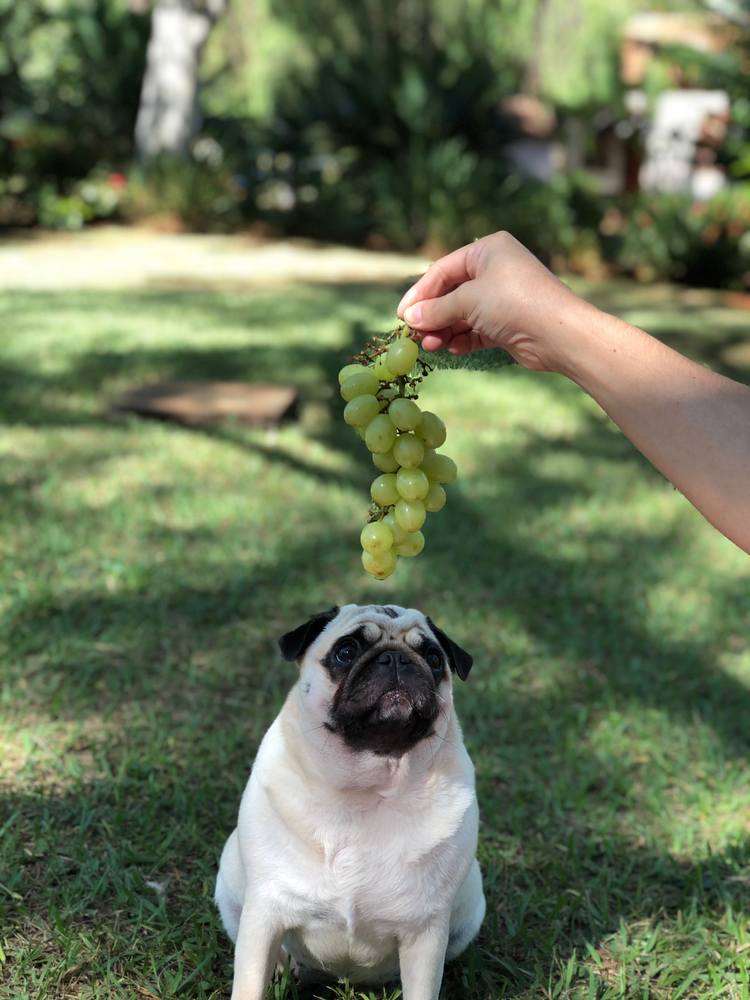
Your dog’s blood pressure will then increase dramatically after this. They can lapse into a coma because of a buildup of substances that the kidneys usually eliminate from the body through urine. The prognosis becomes poor once the kidneys shut down and the urine output drops.
How is Grape Poisoning in Dogs Diagnosed?
Treatment is critical if your dog has ingested grapes or raisins. Unfortunately, symptoms are nonspecific for grape and raisin poisoning. The early signs are similar to those you would notice if your dog ate any other food they shouldn’t eat.
The severe signs are also similar to kidney failure from other causes. If you suspect your dog has ingested grapes or raisins and seems unwell, treat it as an emergency and contact your veterinarian immediately.
They may be able to base a diagnosis of the poisoning on a history of eating grapes, currants, raisins, or the presence of pieces of raisins or grapes in your dog’s vomit. The vet can also recommend a series of diagnostic tests like a serum biochemistry profile, a complete blood count (CBC), or a urinalysis to assess the amount of damage to the kidneys.
The results can help determine the level of poisoning and your dog’s likelihood of recovery. The sooner the poisoning is diagnosed and treated, the less dangerous it will be for your pet.
How is Grape Poisoning in Dogs Treated?
The goal of treatment for grape poisoning in dogs is to block the absorption of the toxins and minimize or prevent damage to the kidneys. The best treatment involves decontaminating your dog right away by inducing vomiting and ingesting activated charcoal. It helps prevent the absorption of the toxin from the stomach or intestines.
Inducing vomiting is important because grapes and raisins stay in the stomach for prolonged periods. However, you should never induce vomiting before contacting your vet or being instructed to do so, especially if you’re unsure of what your dog ate or if they’re unconscious, having trouble breathing, or showing signs of severe shock or distress.
Your dog may vomit on their own, but whether or not they do, you still need to go to the vet immediately. More treatment may be necessary after decontamination. Your dog may require hospitalization, so the vet can administer intravenous fluid therapy to help protect or support the kidneys to minimize damage.
The vet will also monitor your dog’s kidneys through bloodwork and administer drugs to control vomiting and nausea, maintain blood flow to kidneys, and control blood pressure.
Safer Treat Option for Your Dog
Grapes and grape products don’t provide any nutritional value that you can’t substitute with dog-safe fruits like apples and cranberries. Fruits like cranberries are not just good for dogs; they’re super good. They’re full of antioxidants, fiber, quercetin, and proanthocyanidin, which support your dog’s immune system, gut, brain, and urinary health while preventing cancer, allergies, joint pain, and heart disease.
You can easily get safe treat options that include healthy ingredients for your dog at Spot and Tango, where the health and safety of your pup is the number one priority.
Spot & Tango offers both wet and dry dog food options with cranberries. Best of all, all meals are freshly cooked, easy to serve, and personalized to your dog’s unique profile.
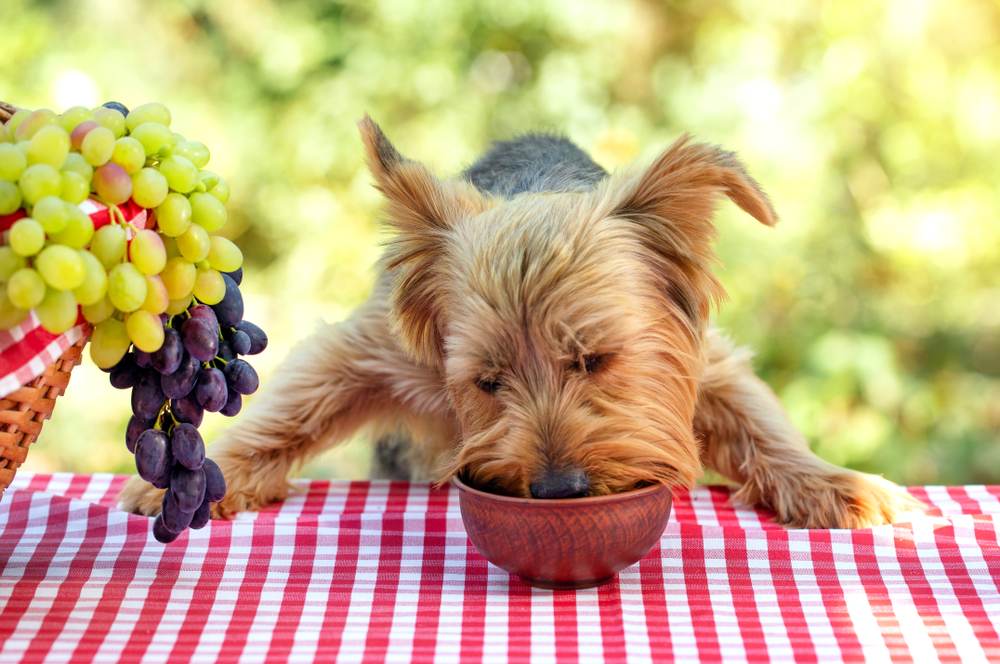
All ingredients are USDA certified, safe for your dog, and 100% human-grade. An excellent fresh recipe is the Spot & Tango Beef & Millet with cranberries and apple cider, while a fantastic dry recipe is the Spot & Tango Beef & Barley Unkibble with cranberries. They’re unsweetened and not mixed with additives, preservatives, or potentially harmful ingredients like grapes.
The best part is that it’s safe for your dog to eat raw, cooked, or freeze-dried cranberries. Giving them as a treat or food in meals works well for general health maintenance and disease prevention.
Veterinary nutritionists formulate all dog food at Spot and Tango to guarantee you complete peace of mind. Check out our list of recipes here.
Frequently Asked Questions
What if Your Dog Eats a Grape or Raisin?
Unfortunately, even one grape or raisin can cause fatal toxicity to your dog and result in sudden or acute kidney failure if left untreated. If you suspect your dog has eaten a grape or raisin, contact your vet or an animal poison control service immediately.
It’s better not to take any risks when it comes to your pup’s health since there are many unknowns associated with grape poisoning. While inducing vomiting is recommended, ensure you first talk to your local vet or pet emergency clinic for assistance. They can advise you accordingly, so you don’t induce vomiting or other treatments unnecessarily.
Your dog’s prognosis will depend on factors like how significant the ingestion is or how soon you decontaminate your dog. It will also depend on whether or not your dog has developed kidney failure, the time you initiated treatment, and if the kidney function and clinical signs have improved since treatment began.
If your dog’s kidneys are damaged and they’re not producing any urine, the prognosis can be poor, and death is likely. The kidneys have very little ability to repair themselves or regenerate. Once they’re damaged, they’ll not function as well as they did before. You should immediately seek treatment from your vet for advice and guidance when in doubt. They can estimate your dog’s prognosis based on their situation, symptoms, and response to treatment.
Can Dogs Eat Green Grapes?
No. All grape varieties are highly toxic to dogs, including the red, green, or purple kind and the seeded and unseeded ones. Speculation abounds about substances like mycotoxin, salicylate, or tartaric acid found in grapes as the cause of the toxin.
However, no specific toxic agent has been conclusively identified or associated with the poison in grapes. Ingestion of green grapes is dangerous for your dog and can cause kidney failure and even death.
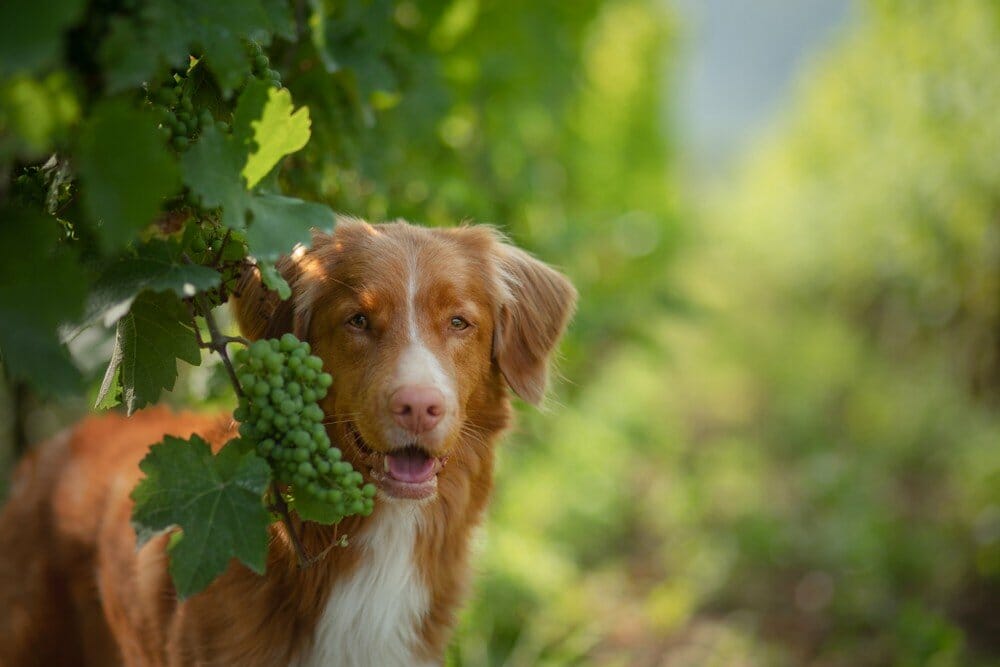
Therefore, it’s wise to keep all grapes, currants, raisins, or foods containing grapes out of the reach of your dog regardless of whether they’re red, purple, or green grapes. Avoid placing them in a bowl on the table or counter because your dog may try them out simply because they’re within reach and they’ve observed your behavior and recognize them as food. It’s also imperative not to use grapes as treats for your dog.
Can Dogs Eat Grape Jelly?
No. You shouldn’t give grape products like grape jelly, grape juice or jam, and even bagels with raisins to your dog. In addition to poisons in the grapes, jelly, juice, and jam contain a lot of sugar, corn syrup, fillers, preservatives, and other unsafe ingredients and additives that can be toxic. These can also lead to additional health issues for your dog, including diabetes and obesity.
Final Thoughts
In short, while most fruits and vegetables are excellent snacks for your pets, you must avoid feeding your dog grapes and grape products like raisins.
The discovery of tartaric acid as a potential toxin in grapes is promising, but more research and studies are necessary for definitive conclusions.
Therefore, it’s a good idea to avoid giving your dog any homemade or commercial foods with cream of tartar ingredients.
Our advice is that the best way to treat your dog is to give them tasty treats formulated for their nutritional needs. Plan your pup’s meal according to his/her needs using Spot and Tango meal planner function, recommended by vet nutritionists.


